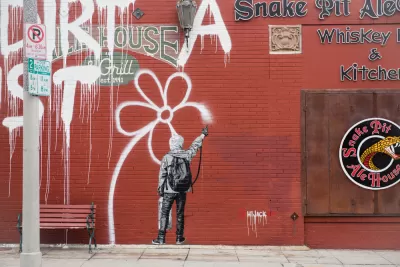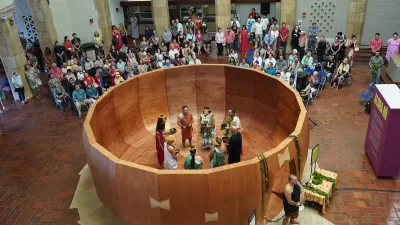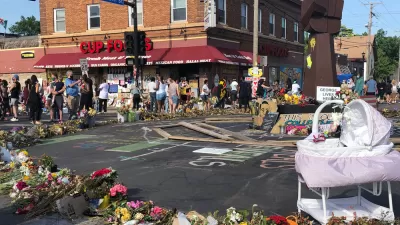Residents use creative engagements to envision an arts and innovation district without displacement in Boston’s Upham’s Corner.

Jason Moreno first learned about redevelopment efforts taking place in his Boston neighborhood on a sunny summer afternoon in July 2018 at his local outdoor basketball court. Dudley Street Neighborhood Initiative (DSNI) had set up a pop-up event to engage local youth about their experiences in the neighborhood. Moreno remembers being asked “what I’d like to see in the neighborhood.”
A year later, Jason was elected to the youth board of DSNI and spent the summer in its youth program, envisioning how a former bank building recently acquired by DSNI’s community land trust could be redeveloped into a youth-friendly space. The program’s culminating project was activating the building with temporary installations using recycled materials, inviting people to interact with what it might be like in the future. For one afternoon, the youth repurposed the first floor of the building into a bowling alley and arcade, Zen garden with koi pond, and movie theater/café.
These arts-based and interactive methods have become part of how DSNI and its community partners are collaborating with the city of Boston to revitalize the Upham’s Corner commercial district into an “arts and innovation” district. Their vision is development without displacement, a tall order given that arts development has often led to gentrification. And Boston has already been experiencing the pressures of a hot real estate market over the last decade.
What makes this redevelopment process different from most is that a democratically-controlled community-based organization owns one of the redevelopment sites and as a result, is a partner in guiding the overall process. DSNI is a co-facilitator with the city of Boston of the Upham’s Corner Implementation (UCI) process. Like many neighborhood groups, DSNI was formed in the mid-1980s to establish community control over development. But DSNI stands apart from most groups with ...
FULL STORY: Arts for Community Control: Planning an Arts and Innovation District Without Displacement

Alabama: Trump Terminates Settlements for Black Communities Harmed By Raw Sewage
Trump deemed the landmark civil rights agreement “illegal DEI and environmental justice policy.”

Planetizen Federal Action Tracker
A weekly monitor of how Trump’s orders and actions are impacting planners and planning in America.

The 120 Year Old Tiny Home Villages That Sheltered San Francisco’s Earthquake Refugees
More than a century ago, San Francisco mobilized to house thousands of residents displaced by the 1906 earthquake. Could their strategy offer a model for the present?

In Both Crashes and Crime, Public Transportation is Far Safer than Driving
Contrary to popular assumptions, public transportation has far lower crash and crime rates than automobile travel. For safer communities, improve and encourage transit travel.

Report: Zoning Reforms Should Complement Nashville’s Ambitious Transit Plan
Without reform, restrictive zoning codes will limit the impact of the city’s planned transit expansion and could exclude some of the residents who depend on transit the most.

Judge Orders Release of Frozen IRA, IIJA Funding
The decision is a victory for environmental groups who charged that freezing funds for critical infrastructure and disaster response programs caused “real and irreparable harm” to communities.
Urban Design for Planners 1: Software Tools
This six-course series explores essential urban design concepts using open source software and equips planners with the tools they need to participate fully in the urban design process.
Planning for Universal Design
Learn the tools for implementing Universal Design in planning regulations.
Clanton & Associates, Inc.
Jessamine County Fiscal Court
Institute for Housing and Urban Development Studies (IHS)
City of Grandview
Harvard GSD Executive Education
Toledo-Lucas County Plan Commissions
Salt Lake City
NYU Wagner Graduate School of Public Service





























